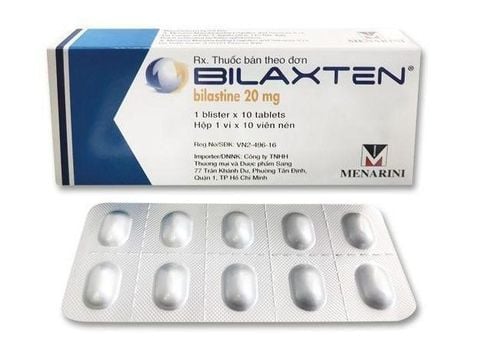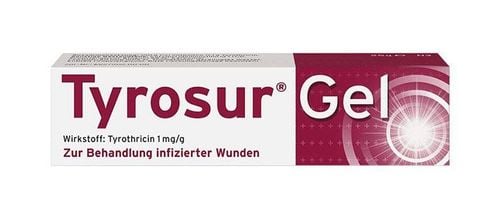This is an automatically translated article.
Ridaflex has the main ingredient Fexofenadine, which is a new generation anti-allergic drug - antihistamine H1 receptor, indicated in cases of allergic rhinitis, seasonal flu, itching, acute urticaria, chronic urticaria baselessness.1. What is Ridaflex?
Ridaflex has the main ingredient Fexofenadine, which is a new generation antiallergic drug - antihistamine H1 receptor, without sedative effect causing sleep. In experimental animals, Ridaflex inhibited antigen-induced bronchoconstriction in susceptible guinea pigs and inhibited histamine secretion from peritoneal mast cells in rats. This drug also does not cross the blood-brain barrier.
Ridaflex is formulated as a film-coated tablet with a strength of 180mg Fexofenadine each.
2. Indications for use of Ridaflex
Allergic rhinitis, seasonal flu for the purpose of symptom relief. Pruritus, urticaria and chronic idiopathic urticaria.
3. Usage and dosage of Ridaflex
3.1. How to use Ridaflex medicine Ridaflex medicine is made in the form of film-coated tablets, when taking the drug, it is necessary to swallow the tablet whole, do not crush the drug. It can be taken with or without food because food does not affect the absorption of the drug. To avoid missed doses, patients should take Ridaflex at a fixed time of day. Before using the drug, the patient should carefully read the instructions for use. Patients should not arbitrarily stop taking or change the dose of Ridaflex without consulting their doctor. If any new symptoms occur during or after taking Ridaflex, the patient should immediately notify the doctor for timely treatment. 3.2. Dosage of Ridaflex Adult
Allergic Rhinitis: Take 60mg/time x 2 times/day or take 180mg/time x 1 time/day. Chronic idiopathic urticaria: Oral 60mg/time x 2 times/day or oral 180mg/time x 1 time/day. Children
Allergic Rhinitis:
Children > 12 years old: Take 60mg/time x 2 times/day or take 180mg/time x 1 time/day. Children from 2 to 11 years old: Take 30mg/time x 2 times/day. Idiopathic chronic urticaria:
Children 12 years and older: Take 60mg/time x 2 times/day or take 180mg/time x 1 time/day. Children from 2 to 11 years old: Take 30mg/time x 2 times/day. Children from 6 months to 2 years: Take 15mg/time x 2 times/day. Children from 2 to 11 years old with kidney failure: Take 30mg/time x 1 time/day. Other subjects
Adults with renal failure and the elderly: Start from a dose of 60mg orally once a day, then adjust the dose according to renal function.
4. Contraindications of Ridaflex
Do not use Ridaflex in patients with a history of allergy or hypersensitivity to Fexofenadine or any other ingredient of Ridaflex, in patients with a history of allergy to the H1 class of antihistamines.
5. Unwanted side effects of Ridaflex
Common undesirable effects are:
Nervous system: Drowsiness, dizziness, fatigue, headache. Digestive system: Nausea, indigestion. Respiratory system: Vulnerable to viruses (cold, flu), susceptible to upper respiratory infections, itchy throat, cough, fever, sinusitis. Musculoskeletal system: Back pain. Abdominal pain during menstruation. Undesirable effects are less common:
Sleep disturbance, sleep with nightmares. Dry mouth, stomach upset. Rare side effects are:
Anaphylactic reactions: Mild rash, urticaria, itching, severe angioedema, chest tightness, dyspnea, Quincke's edema.
6. Precautions while using Ridaflex
When using Ridaflex, patients should note the following information:
Care should be taken and the dose of Ridaflex should be adjusted appropriately when used in patients with impaired renal function and the elderly (over 65 years old) physiological decline in renal function. The safety and effectiveness of Ridaflex in children under 6 months of age have not been established. Ridaflex should be discontinued at least 24-48 hours before conducting intradermal antigen tests in patients. Use caution when using Ridaflex in patients with psoriasis because the drug aggravates the disease. Because of the risk of overdose and toxicity (including death) in children under 2 years of age when taking antihistamines, including Ridaflex, these preparations should not be used in children < 2 years of age. age. The use of fixed combination preparations containing 180 mg Ridaflex and 240 mg Pseudoephedrine hydrochloride should be avoided in patients with renal impairment because of possible increased risk of accumulation of Pseudoephedrine. Note to pregnant women: Currently, because there are no adequate studies on the use of Ridaflex in pregnant women, Ridaflex should only be used in pregnant women when prescribed by a doctor with benefits for the mother. outweighs the risk to the fetus. Note to nursing women: It is not known whether Ridaflex is excreted in breast milk or not, although no adverse effects have been observed in infants when breast-feeding mothers take Ridaflex, but it is still recommended to consult. Consult your doctor and use caution when administering Ridaflex to a nursing woman. Notes on driving and operating machines: Ridaflex has not been shown to have a significant effect on central nervous system function and should therefore not affect attention-seeking subjects. However, in order to identify susceptible individuals who have had a hypersensitivity reaction to the components of Ridaflex, caution should be exercised when administering the drug before driving, operating machinery or performing tasks requiring high concentration.
7. Ridaflex drug interactions
When using Ridaflex, patients should pay attention to avoid the following drug interactions:
Erythromycin and Ketoconazole increase the plasma concentration of Ridaflex but do not change the QT interval on the electrocardiogram. Ridaflex concentrations may be increased by drugs such as Erythromycin, Ketoconazole, Verapamil, P-glycoprotein inhibitors. Do not use Ridaflex concurrently with antacids containing aluminum, magnesium because it will reduce the absorption of Ridaflex. Ridaflex may increase the concentration of alcohol, central nervous system sedatives and anticholinergics. Ridaflex may reduce the concentration of Acetylcholinesterase (CNS) inhibitors, Betahistine. Ridaflex may be reduced in concentrations by Acetylcholinesterase (CNS) inhibitors, Amphetamines, antacids, Rifampin. Fruit juices (oranges, grapefruits, apples) can significantly reduce the bioavailability of Ridaflex, so avoid taking Ridaflex with fruit juices. Avoid taking Ridaflex with ethyl alcohol (alcohol) because it increases the risk of sedation (sleep). Ridaflex may decrease the effectiveness of Benzyl Penicilloyl polylysine as a diagnostic agent. The therapeutic effect of Betahistine, Hyaluronidase may be reduced when used in combination with Ridaflex. The excretion of Ridaflex can be reduced when combined with Aspartame, Cefotiam, Cefalotin, Tenoxicam. Cefotaxime, Cefdinir, Guanidin. Above is the information about the drug Ridaflex. However, patients need to consult their doctor, pharmacist before using Ridaflex to achieve the best effect and limit unwanted side effects. Note, Ridaflex is a prescription drug, patients need to use the drug as prescribed by the doctor, absolutely do not buy drugs for home treatment.













